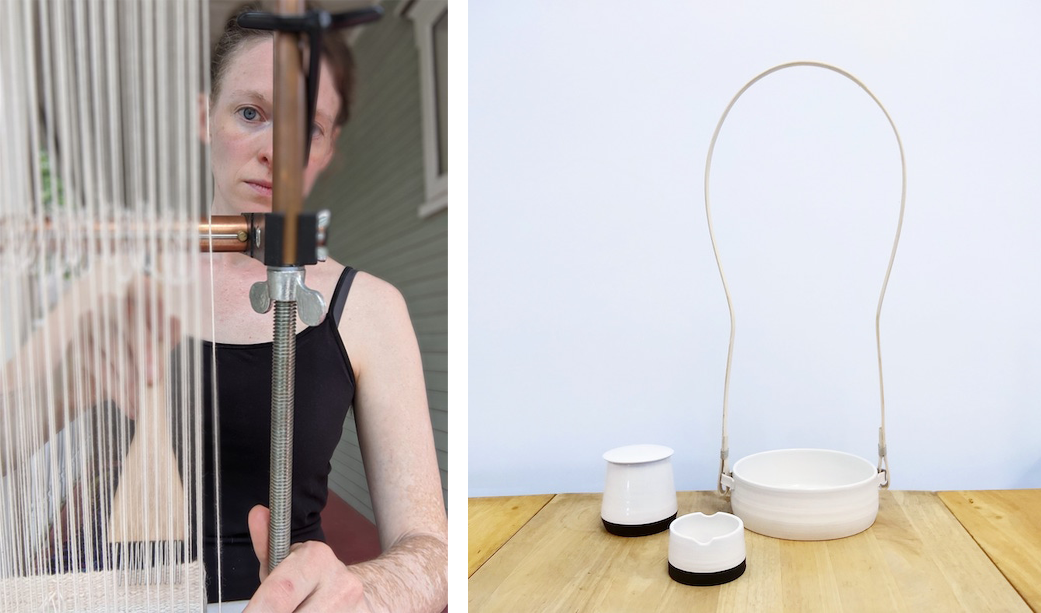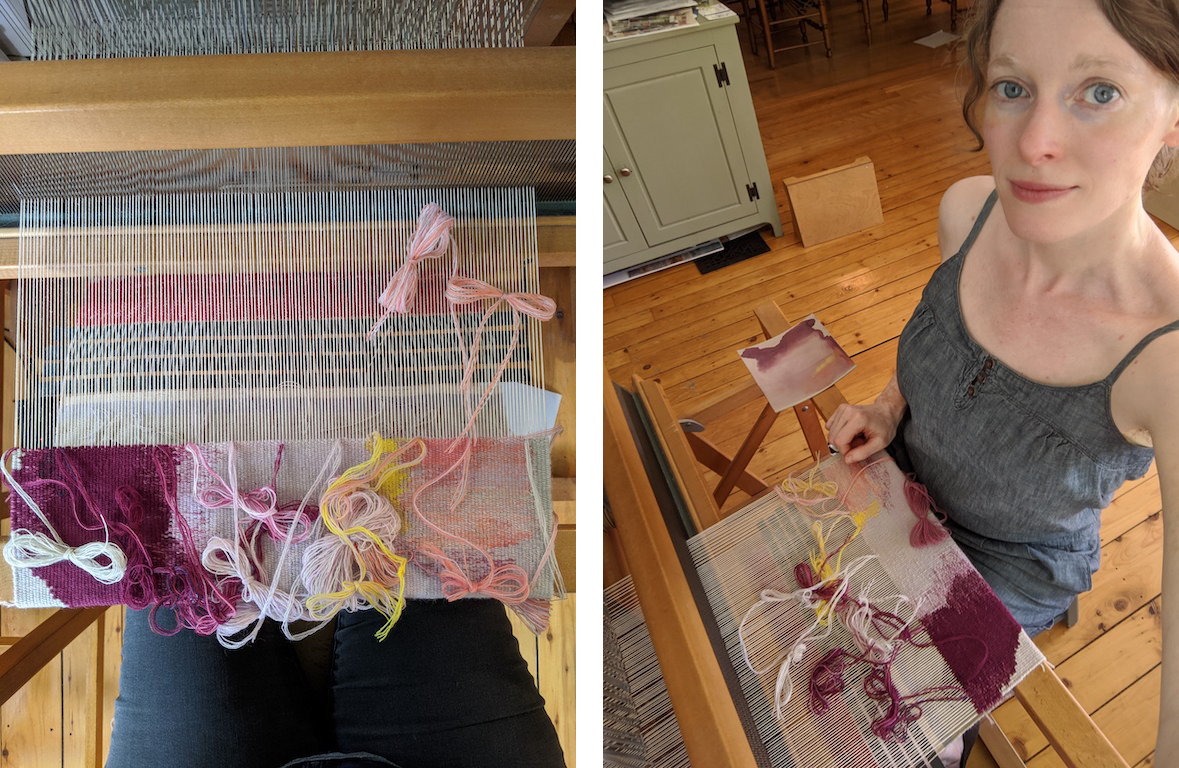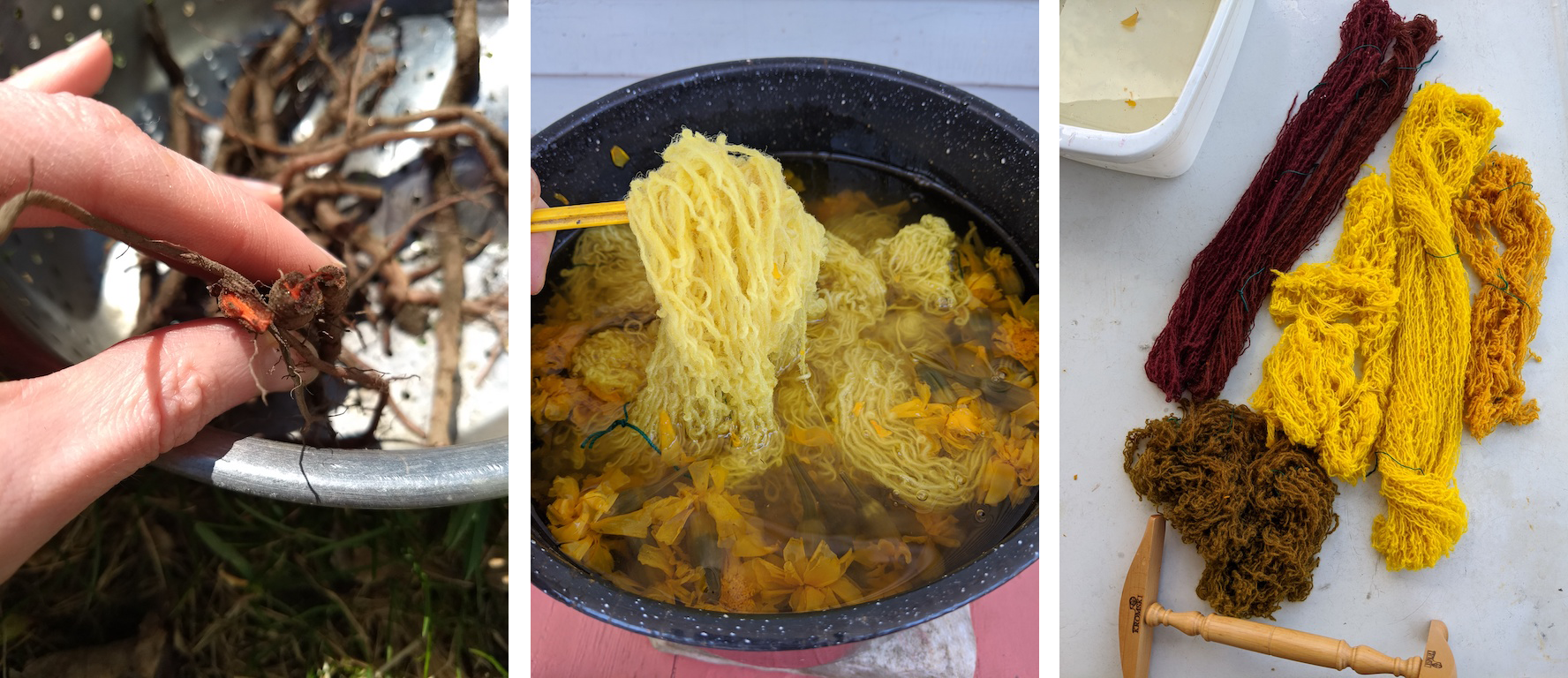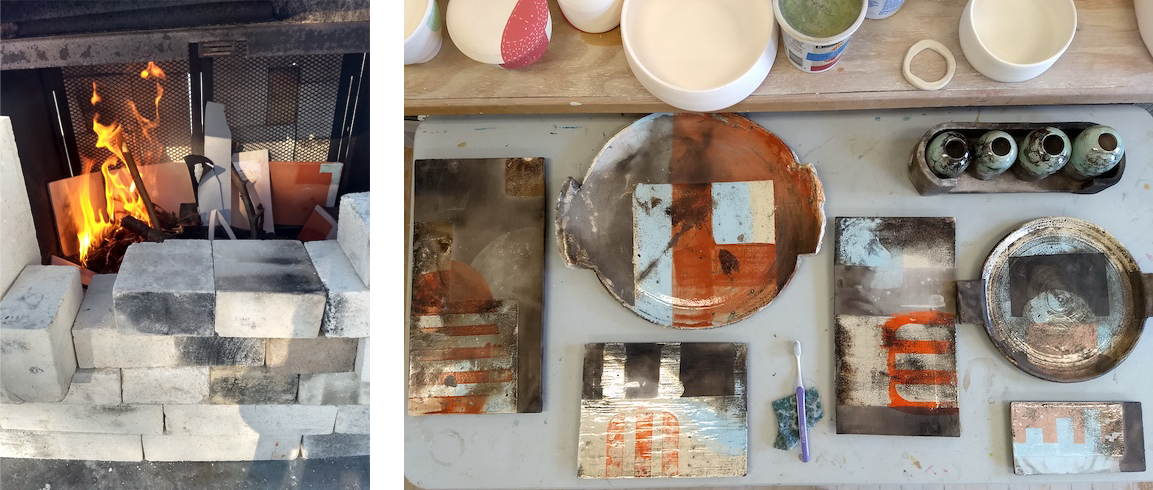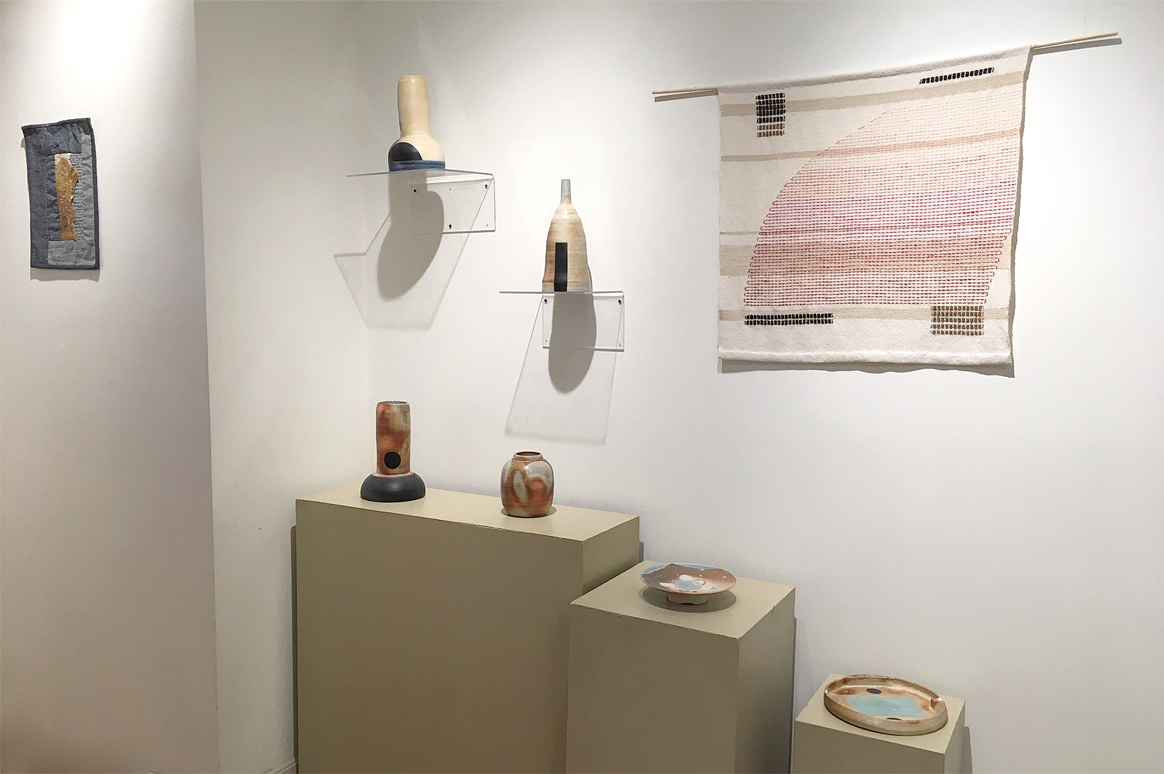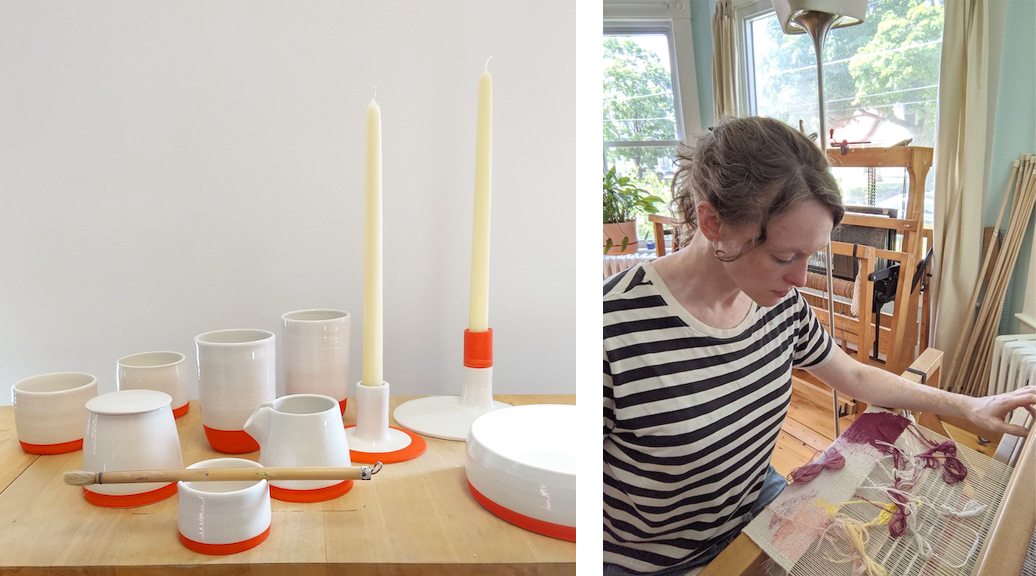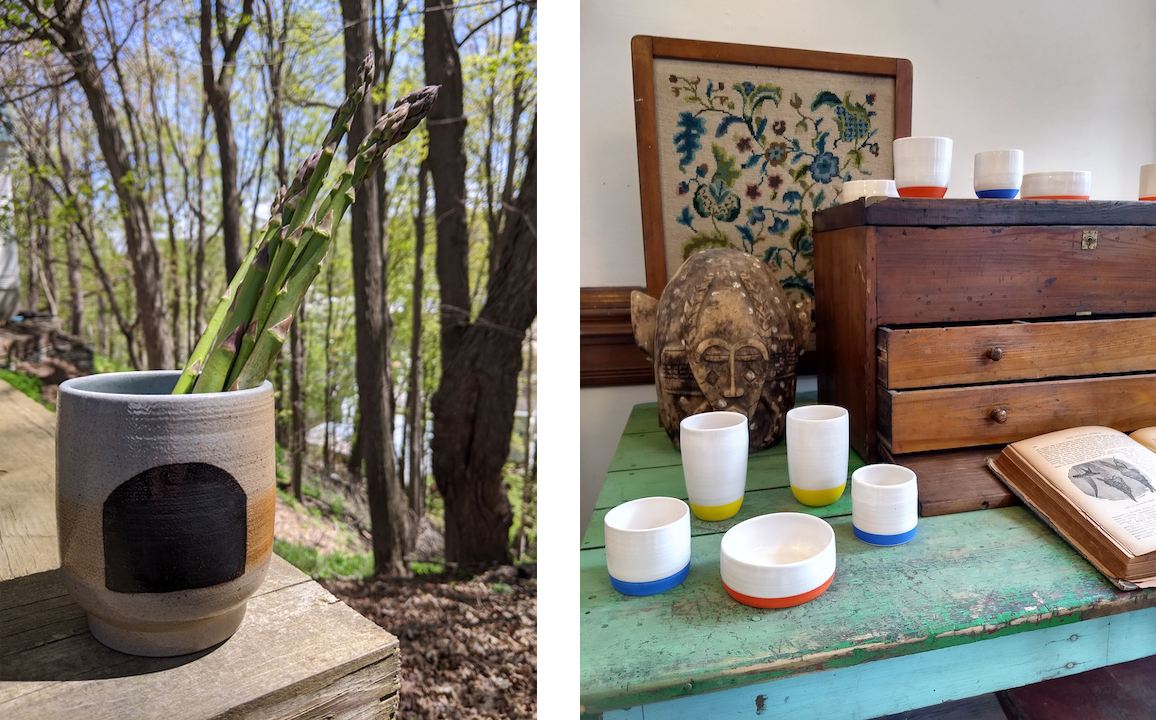Spotlight Artist Interview
Pamela Wilson
June 2020
SPA: How would you describe the type of work you create?
Pamela: There's two ways to answer that question. One is straightforward--I work in clay and fiber. I make cloth and I make pots. If that's all somebody takes away from a studio or gallery visit, I'm not unsatisfied. That role as a maker is really fundamental to the way that I move through the world.
The other way to talk about my work is more conceptual and this is where things get interesting for me. I'm an artist who is very deeply rooted in the world of craft--craftsmanship, craft aesthetics, craft histories, material culture and performative craft (the power of intentionally making things in public as performance.) The finished object, the process of how the object is currently or has historically made and the environmental/human impact of the chosen materials and processes are bound together in my work. It's an integrative worldview that reflects an ethic of caretaking and interdependence. I tend to work in very elemental, labor intense processes in a post-industrial world full of quick, cheap, easily obtainable alternatives. So why bother, right?
There's a very human, spiritual element for me. When I make cloth--the receiving blankets I'm showing on the third floor at SPA, for example--I'm often spinning, growing dye-stuffs, noticing the impact of my watershed on the colors I'm developing and thinking about the role and power of a baby's blanket. It's the sheep, the baby, the need for warmth, the dye plants, the warp, the weft, all at once. The work is the blankets, but also the act of holding all those things at once and making a decision about what happens next in the threads.
Pamela: There's two ways to answer that question. One is straightforward--I work in clay and fiber. I make cloth and I make pots. If that's all somebody takes away from a studio or gallery visit, I'm not unsatisfied. That role as a maker is really fundamental to the way that I move through the world.
The other way to talk about my work is more conceptual and this is where things get interesting for me. I'm an artist who is very deeply rooted in the world of craft--craftsmanship, craft aesthetics, craft histories, material culture and performative craft (the power of intentionally making things in public as performance.) The finished object, the process of how the object is currently or has historically made and the environmental/human impact of the chosen materials and processes are bound together in my work. It's an integrative worldview that reflects an ethic of caretaking and interdependence. I tend to work in very elemental, labor intense processes in a post-industrial world full of quick, cheap, easily obtainable alternatives. So why bother, right?
There's a very human, spiritual element for me. When I make cloth--the receiving blankets I'm showing on the third floor at SPA, for example--I'm often spinning, growing dye-stuffs, noticing the impact of my watershed on the colors I'm developing and thinking about the role and power of a baby's blanket. It's the sheep, the baby, the need for warmth, the dye plants, the warp, the weft, all at once. The work is the blankets, but also the act of holding all those things at once and making a decision about what happens next in the threads.
SPA: How has the health crisis / shutdown impacted your art-making practice? Are you still able to create? How are you adapting?
Pamela: Every single part of my ecosystem has been impacted and transformed in some way and continues to transform on a daily basis. I think this is true for many folks. I make my living as a maker and as a perinatal psychotherapist and I am a parent with strong ties to my school & local community. That means I'm either actively talking to folks (adults or children, clients or neighbors,) caring for folks, connecting folks with resources or just *thinking* about this stuff to prepare for the next day constantly. It's been a lot. Art-wise, all my summer shows and markets were cancelled and galleries were closed, so that felt incredibly sad, but very straightforward.
One of the truisms in both art and psychotherapy is that as the maker/clinician, you gotta stay alive if you want to serve your community (or your muse, if that's how you imagine it) another day. At first, I was oriented towards making sure my immediate family, neighborhood and community were okay-enough had access to basic needs. I adapted my practice for telemedicine, so as not to abandon my patients and got our household ready so that we could do remote learning. I tried to adapt how I practice as a mental health provider and artist to get ready to receive and metabolize the huge groundswell of grief and mourning that folks were experiencing. It was a lot of emotional labor.
I tried to think strategically and take on whatever little piece of that I could manage. We volunteer to host the Pete's Green's CSA at our house, so we evaluated how we could continue to safely be a hub for our high-risk neighbors and community to access fresh food. I tried to make art-making materials available to my students who didn't have them at home. We started making masks, based on the guidance of friends who work in harm-reduction on the west coast and in other parts of the world who had already been navigating the virus. It was exhausting and purposeful at the same time. We focused on mask-making for several weeks.
I didn't have a lot of creative energy for design and development. Luckily, because my processes are relatively labor intense, I didn't need to have new aesthetic ideas to move ahead in my art-making. Part of the blessing of being a craft artist is that there's always more work to do. (Look out--this is also part of the curse of labor intensive craft processes!) There's always more wool to spin, gardens to prep, bricks to move, kilns to rebuild, clay to wedge, glazes to mix, looms to warp. I've been spending extra moments deep in these parts of the process, so I'm ready for the new designs whenever they emerge. I can feel the subtle shifts inside that usually indicate new work is gestating. It'll come.
Pamela: Every single part of my ecosystem has been impacted and transformed in some way and continues to transform on a daily basis. I think this is true for many folks. I make my living as a maker and as a perinatal psychotherapist and I am a parent with strong ties to my school & local community. That means I'm either actively talking to folks (adults or children, clients or neighbors,) caring for folks, connecting folks with resources or just *thinking* about this stuff to prepare for the next day constantly. It's been a lot. Art-wise, all my summer shows and markets were cancelled and galleries were closed, so that felt incredibly sad, but very straightforward.
One of the truisms in both art and psychotherapy is that as the maker/clinician, you gotta stay alive if you want to serve your community (or your muse, if that's how you imagine it) another day. At first, I was oriented towards making sure my immediate family, neighborhood and community were okay-enough had access to basic needs. I adapted my practice for telemedicine, so as not to abandon my patients and got our household ready so that we could do remote learning. I tried to adapt how I practice as a mental health provider and artist to get ready to receive and metabolize the huge groundswell of grief and mourning that folks were experiencing. It was a lot of emotional labor.
I tried to think strategically and take on whatever little piece of that I could manage. We volunteer to host the Pete's Green's CSA at our house, so we evaluated how we could continue to safely be a hub for our high-risk neighbors and community to access fresh food. I tried to make art-making materials available to my students who didn't have them at home. We started making masks, based on the guidance of friends who work in harm-reduction on the west coast and in other parts of the world who had already been navigating the virus. It was exhausting and purposeful at the same time. We focused on mask-making for several weeks.
I didn't have a lot of creative energy for design and development. Luckily, because my processes are relatively labor intense, I didn't need to have new aesthetic ideas to move ahead in my art-making. Part of the blessing of being a craft artist is that there's always more work to do. (Look out--this is also part of the curse of labor intensive craft processes!) There's always more wool to spin, gardens to prep, bricks to move, kilns to rebuild, clay to wedge, glazes to mix, looms to warp. I've been spending extra moments deep in these parts of the process, so I'm ready for the new designs whenever they emerge. I can feel the subtle shifts inside that usually indicate new work is gestating. It'll come.
SPA: In your opinion, what is the role of “the artist” in society?
Pamela: Hmmm...If you're going to spend some time reading about the topics of art, survival, community and the preservation of body & hand-based crafts, spend some time reading Vanessa German, the Pittsburgh-based multi-media artist, fiber artist Avery Williamson, musician/chef/activist/archivist Ben Hall, craft scholar Namita Gupta Wiggers or Porfirio Gutierrez.
SPA: You organized and collaborated with three other artists to create our exhibit on the third floor, “The Edges and Corners of the Day”. Could you tell us a bit about your experience collaborating with other artists? More broadly, how does the sense of “community” impact your work?
Pamela: I love being in collaboration with other artists. It's one of the more enlivening parts of the process. Being in the studio can feel a little lonely without a crew who you feel connected to. Working with Kim, Alana and Sarah to develop "The Edges and Corners of the Day" was a really interesting experience. We each share a similar ethic of caretaking, improvisation and community care in our arts practice. We had to have some complicated conversations and keep checking in with each other and Sue and Athena when it became clear to us that installing the show wasn't risk-free. We then had to talk about how inviting the public to the show could be something that was potentially hazardous to the community we had hoped to serve. I've known Kim since we were teenagers and haven't seen her in person since we were students. Sarah and I have really only spend a handful of afternoons together, yet here were were having these incredibly intimate conversations about health and risk and art-making. This was Alana's first show ever--poor woman! Hopefully, she knows it's not always this intense!
Pamela: I love being in collaboration with other artists. It's one of the more enlivening parts of the process. Being in the studio can feel a little lonely without a crew who you feel connected to. Working with Kim, Alana and Sarah to develop "The Edges and Corners of the Day" was a really interesting experience. We each share a similar ethic of caretaking, improvisation and community care in our arts practice. We had to have some complicated conversations and keep checking in with each other and Sue and Athena when it became clear to us that installing the show wasn't risk-free. We then had to talk about how inviting the public to the show could be something that was potentially hazardous to the community we had hoped to serve. I've known Kim since we were teenagers and haven't seen her in person since we were students. Sarah and I have really only spend a handful of afternoons together, yet here were were having these incredibly intimate conversations about health and risk and art-making. This was Alana's first show ever--poor woman! Hopefully, she knows it's not always this intense!
Pamela: Right now I'm participating in a national collaborative project developed by Brooke and Justin Rothshank called the Sharing Intention Project. The couple, who come out of the Mennonite social justice tradition, spent a year in conversation within their household about a chosen weekly intention. Brooke illustrated each intention and Justin fired the image onto his jugs and vessels. An intention was paired with each state and territory and the recipient agreed to accept the gift of the clay piece, in exchange for having conversations in their own homes and communities about the chosen intention. The intention paired with Vermont was "prepare." This project started before the covid crisis began, so the conversations I've had within my own home and community about what it means to be physically, emotionally and spiritually prepared for this new world have gained much greater depth as the weeks have gone on.
Craft survives through student/mentorship/apprenticeship processes wherein we pass along historical knowledge about making processes and make intentional decisions about what to hold on to and what to reject in our own individual or collective art practices. Really important questions about what makes a healthy, mutually nurturing mentor/learning community or community of collaboration are seeping into the art/craft mainstream. The conversations about equity, compensation, cultural knowledge and caring for both the cultural heritage of making, the objects/collections and the bodies of the makers themselves are really thrilling. This includes exploring the legacy & impact of white supremacy, specific histories of oppression and harm and identifying how histories of trauma and loss have impacted craft, aesthetics, material culture and makers. Namita Gupta Wiggers is doing such important work in this vein at Warren Wilson College and in online forums like the Critical Craft Forum. Communities of color, working class artists and marginalized folks have been having these conversations about the art/craft world, institutions and art/craft pedagogies for so long. It's exciting to see folks in my immediate community either catch up or continue engaging with these conversations and being moved by them.
Craft survives through student/mentorship/apprenticeship processes wherein we pass along historical knowledge about making processes and make intentional decisions about what to hold on to and what to reject in our own individual or collective art practices. Really important questions about what makes a healthy, mutually nurturing mentor/learning community or community of collaboration are seeping into the art/craft mainstream. The conversations about equity, compensation, cultural knowledge and caring for both the cultural heritage of making, the objects/collections and the bodies of the makers themselves are really thrilling. This includes exploring the legacy & impact of white supremacy, specific histories of oppression and harm and identifying how histories of trauma and loss have impacted craft, aesthetics, material culture and makers. Namita Gupta Wiggers is doing such important work in this vein at Warren Wilson College and in online forums like the Critical Craft Forum. Communities of color, working class artists and marginalized folks have been having these conversations about the art/craft world, institutions and art/craft pedagogies for so long. It's exciting to see folks in my immediate community either catch up or continue engaging with these conversations and being moved by them.
SPA: What inspires you? Is there a running theme or message you are trying to communicate through your art?
Pamela: Oh, I'm inspired or moved by all the things I've been describing today. Did you drink from a clay cup, pull on a piece of clothing or think of a loved one today? It's simultaneously sacred and utterly commonplace, the cup, the pants, the relationship. As a maker of functional objects, that tension is so compelling.
Pamela: Oh, I'm inspired or moved by all the things I've been describing today. Did you drink from a clay cup, pull on a piece of clothing or think of a loved one today? It's simultaneously sacred and utterly commonplace, the cup, the pants, the relationship. As a maker of functional objects, that tension is so compelling.
Follow Pamela on Instagram: @pamelawilsonstudio & View more of Pamela's work at: www.pamelalynnwilson.com

